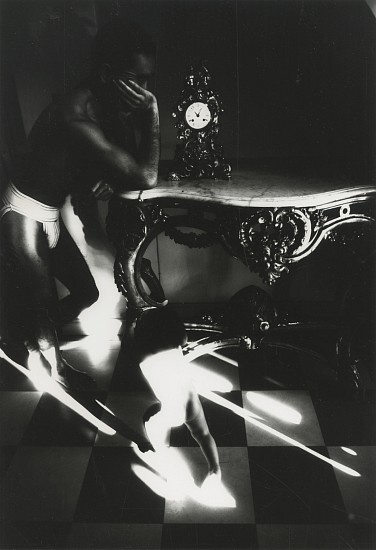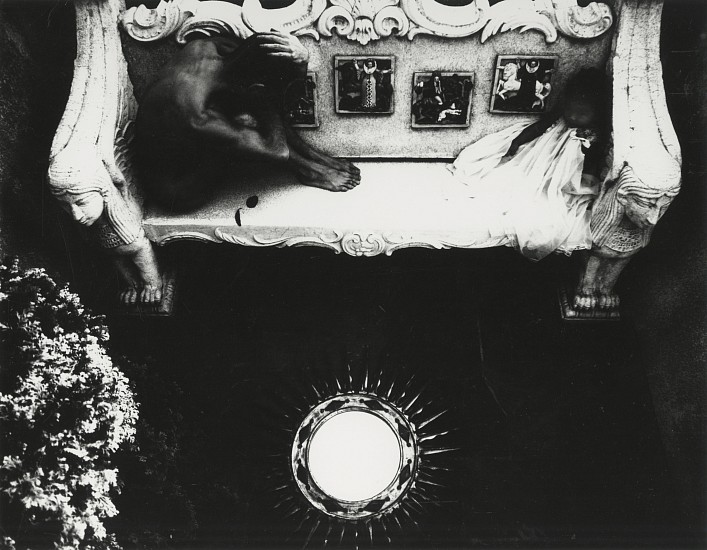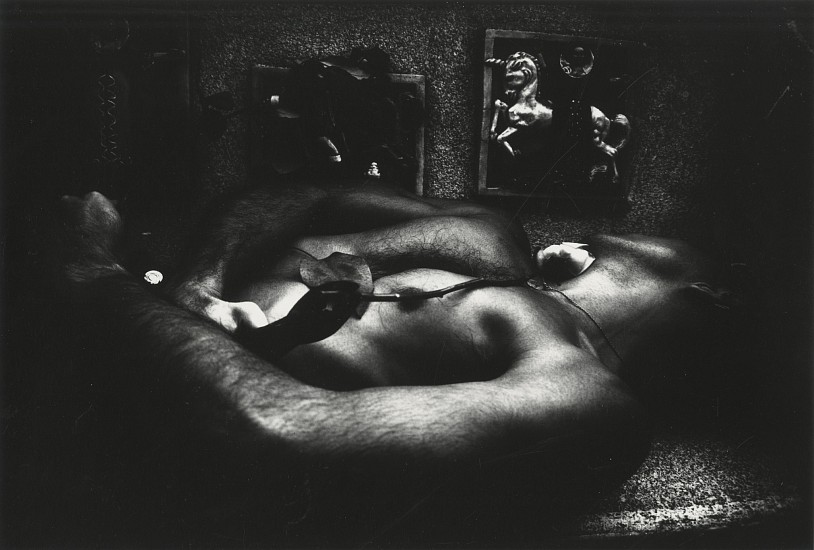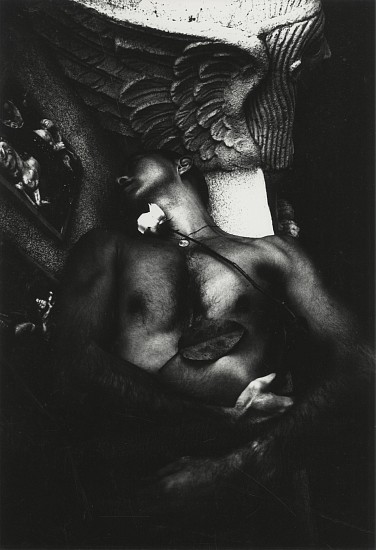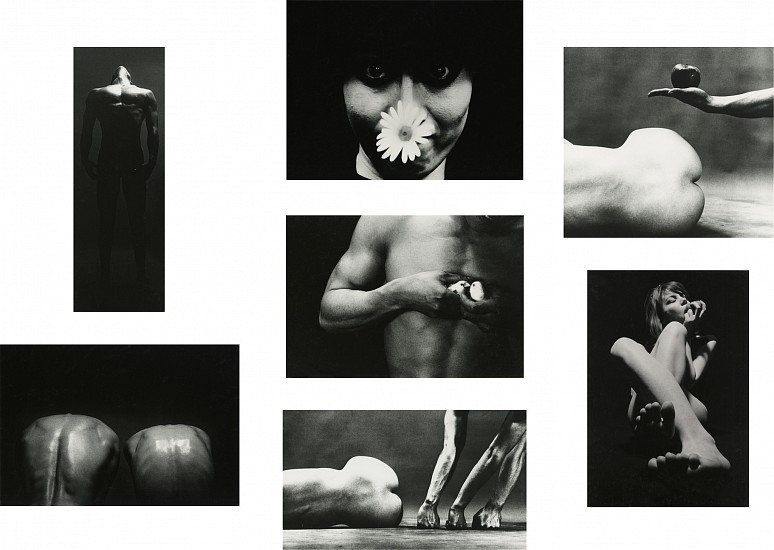Eikoh Hosoe


Eikoh Hosoe, Barakei #3, 1961
Early gelatin silver print; printed no later than 1970, 11 1/2 x 7 15/16 in. (29.2 x 20.2 cm)
Mounted 18x14 inches with original window mat; signed in pencil on mount recto; notations in pencil on mount verso.
8538
$6,000
This work is a part of a series of images Eikoh Hosoe made over a 6-month period in 1961 of Yukio Mishima, a Japanese author, poet, playwright, actor, model, Shintoist, nationalist, and founder of the Tatenokai. Mishima presented as a person of apparent contradictions. He embraced and promoted traditional Japanese culture while also being rather cosmopolitan. He writing style had elements of both traditional Japanese and Western literary styles. His merging of ideas about beauty, eroticism and death shocked many and enticed others. Though married to a woman, it was unclear if he was gay or bisexual. It is said that he was very controlling about who he would allow to photograph him. Earlier in 1961, Hosoe made a portrait of him for Mishima's 1961 book of critical essays, The Attack on Beauty, after he had admired Hosoe's photographs of the dancer and founder of Butoh, Tatsumi Hijikata.
Interesting note: Hosoe asked Mishima to title the body of work and he chose Barakei, which was translated as Killed by Roses in English for the first publication in 1963. The title of the second edition (1971), which came out after Mishima's death, was translated in English as Ordeal by Roses.
LINK to trailer of Mishima: A Life in Four Chapters, directed by Paul Shrader, 1985.


Eikoh Hosoe, Barakei #40, 1962
Early gelatin silver print; printed no later than 1970, 8 7/8 x 11 5/16 in. (22.5 x 28.7 cm)
Mounted 14x18 inches with original window mat; signed in pencil on mount recto; notations in pencil on mount verso.
8542
$7,000
This work is a part of a series of images Eikoh Hosoe made over a 6-month period in 1961 of Yukio Mishima, a Japanese author, poet, playwright, actor, model, Shintoist, nationalist, and founder of the Tatenokai. Mishima presented as a person of apparent contradictions. He embraced and promoted traditional Japanese culture while also being rather cosmopolitan. He writing style had elements of both traditional Japanese and Western literary styles. His merging of ideas about beauty, eroticism and death shocked many and enticed others. Though married to a woman, it was unclear if he was gay or bisexual. It is said that he was very controlling about who he would allow to photograph him. Earlier in 1961, Hosoe made a portrait of him for Mishima's 1961 book of critical essays, The Attack on Beauty, after he had admired Hosoe's photographs of the dancer and founder of Butoh, Tatsumi Hijikata.
Interesting note: Hosoe asked Mishima to title the body of work and he chose Barakei, which was translated as Killed by Roses in English for the first publication in 1963. The title of the second edition (1971), which came out after Mishima's death, was translated in English as Ordeal by Roses.
LINK to trailer of Mishima: A Life in Four Chapters, directed by Paul Shrader, 1985.


Eikoh Hosoe, Barakei #39, 1961
Early gelatin silver print; printed 1970s, 8 x 11 13/16 in. (20.3 x 30 cm)
Artist stamp and annotated 'VSW EH11' in pencil on print verso.
8541
$6,000
This work is a part of a series of images Eikoh Hosoe made over a 6-month period in 1961 of Yukio Mishima, a Japanese author, poet, playwright, actor, model, Shintoist, nationalist, and founder of the Tatenokai. Mishima presented as a person of apparent contradictions. He embraced and promoted traditional Japanese culture while also being rather cosmopolitan. He writing style had elements of both traditional Japanese and Western literary styles. His merging of ideas about beauty, eroticism and death shocked many and enticed others. Though married to a woman, it was unclear if he was gay or bisexual. It is said that he was very controlling about who he would allow to photograph him. Earlier in 1961, Hosoe made a portrait of him for Mishima's 1961 book of critical essays, The Attack on Beauty, after he had admired Hosoe's photographs of the dancer and founder of Butoh, Tatsumi Hijikata.
Interesting note: Hosoe asked Mishima to title the body of work and he chose Barakei, which was translated as Killed by Roses in English for the first publication in 1963. The title of the second edition (1971), which came out after Mishima's death, was translated in English as Ordeal by Roses.
LINK to trailer of Mishima: A Life in Four Chapters, directed by Paul Shrader, 1985.


Eikoh Hosoe, Barakei #38, 1961
Early gelatin silver print; printed no later than 1970, 11 3/16 x 7 11/16 in. (28.4 x 19.5 cm)
Mounted 18x14 inches with original window mat; signed in pencil on mount recto; notations in pencil on mount verso.
8539
$7,000
This work is a part of a series of images Eikoh Hosoe made over a 6-month period in 1961 of Yukio Mishima, a Japanese author, poet, playwright, actor, model, Shintoist, nationalist, and founder of the Tatenokai. Mishima presented as a person of apparent contradictions. He embraced and promoted traditional Japanese culture while also being rather cosmopolitan. He writing style had elements of both traditional Japanese and Western literary styles. His merging of ideas about beauty, eroticism and death shocked many and enticed others. Though married to a woman, it was unclear if he was gay or bisexual. It is said that he was very controlling about who he would allow to photograph him. Earlier in 1961, Hosoe made a portrait of him for Mishima's 1961 book of critical essays, The Attack on Beauty, after he had admired Hosoe's photographs of the dancer and founder of Butoh, Tatsumi Hijikata.
Interesting note: Hosoe asked Mishima to title the body of work and he chose Barakei, which was translated as Killed by Roses in English for the first publication in 1963. The title of the second edition (1971), which came out after Mishima's death, was translated in English as Ordeal by Roses.
LINK to trailer of Mishima: A Life in Four Chapters, directed by Paul Shrader, 1985.


Eikoh Hosoe, Barakei #29, 1961
Early gelatin silver print; printed 1970s, 11 1/2 x 8 1/8 in. (29.2 x 20.6 cm)
Artist stamp and 'VSW EH10' in pencil on print verso.
8537
$5,500
This work is a part of a series of images Eikoh Hosoe made over a 6-month period in 1961 of Yukio Mishima, a Japanese author, poet, playwright, actor, model, Shintoist, nationalist, and founder of the Tatenokai. Mishima presented as a person of apparent contradictions. He embraced and promoted traditional Japanese culture while also being rather cosmopolitan. He writing style had elements of both traditional Japanese and Western literary styles. His merging of ideas about beauty, eroticism and death shocked many and enticed others. Though married to a woman, it was unclear if he was gay or bisexual. It is said that he was very controlling about who he would allow to photograph him. Earlier in 1961, Hosoe made a portrait of him for Mishima's 1961 book of critical essays, The Attack on Beauty, after he had admired Hosoe's photographs of the dancer and founder of Butoh, Tatsumi Hijikata.
Interesting note: Hosoe asked Mishima to title the body of work and he chose Barakei, which was translated as Killed by Roses in English for the first publication in 1963. The title of the second edition (1971), which came out after Mishima's death, was translated in English as Ordeal by Roses.
LINK to trailer of Mishima: A Life in Four Chapters, directed by Paul Shrader, 1985.
Eikoh Hosoe, Man and Woman, 1959-1960
32 early gelatin silver prints; printed c. 1960 Image sizes 4 x 7 3/8 in. (10.2 x 18.7 cm) to 9 3/ 16 x 11 11/16 (23.3 x 29.7 cm) Each mounted to mat board hinged to window mats 14 x 18 in.
8586
$90,000
Illustrated: Hosoe, Eikoh. Man and Woman. Camer Art, 1961.
Eikoh Hosoe’s relationships with avant-garde artists Tatsumi Hijikata (the dancer and choreographer and founder of Butoh) and Yukio Mishima (author, poet, playwright, actor, model, Shintoist, nationalist, and founder of the Tatenokai) are seminal to much of his work. All three were creating work in postwar Japan that rejected convention and inspired a greater freedom of expression.
Man and Woman, 1959-60, pictures Tatsumi Hijikata, his students, fellow dancers, and fashion model Masako Ishida. The images are provocative and express a visceral and psychological exploration of human touch and interaction through the movement of dance.
Hosoe initially met Hijikata in 1959 at his first Butoh performance, KinjikiI (Forbidden Colors), which was based on a novel by Yukio Mishima. Mishima was so enamored by Hosoe’s images of Hijikata, that Mishima asked Hosoe to photograph him for his 1961 book of critical essays, The Attack on Beauty and later they created Hosoe’s other famous series Barakei (Killed by Roses/Ordeal by Roses).
LINK to full set
Eikoh Hosoe, Kamaitachi, 1965-68
38 early gelatin silver prints Image sizes range from 6 5/8 x 11 3/8 in. (17 x 29 cm) to 8 1/4 x 11 3/4 in. (21 x 30 cm) Each mounted to mat board hinged to window mats 18x22 in. With title sheet "Kamaitachi/ an extravagantly tragic comedy" taped to 18x22in window mat and 2 layout dummy sheets made with contact prints with corresponding numbers to those on mats verso in pencil.
8587
$96,000
Illustrated: Hosoe, Eikoh. Kamaitachi. Gendai Shicho Sha, 1969.
Eikoh Hosoe’s relationships with avant-garde artists Tatsumi Hijikata (the dancer and choreographer and founder of Butoh) and Yukio Mishima (author, poet, playwright, actor, model, Shintoist, nationalist, and founder of the Tatenokai) are seminal to much of his work. All three were creating work in postwar Japan that rejected convention and inspired a greater freedom of expression.
In Hosoe’s 1965-68 series Kamaitachi, each image is a “happening” visualizing a supernatural weasel-like being from Japanese folklore rampaging through the countryside. The Kamaitachi is played by Tatsumi Hijikata and the other people are friends acting, collaborators in the happenings. Both Hosoe and Hijikata are from Northern Japan where the images were made.
Hosoe initially met Hijikata in 1959 at his first Butoh performance, KinjikiI (Forbidden Colors), which was based on a novel by Yukio Mishima. Mishima was so enamored by Hosoe’s images of Hijikata, that Mishima asked Hosoe to photograph him for his 1961 book of critical essays, The Attack on Beauty and later they created Hosoe’s other famous series Barakei (Killed by Roses/Ordeal by Roses).
LINK to full set








